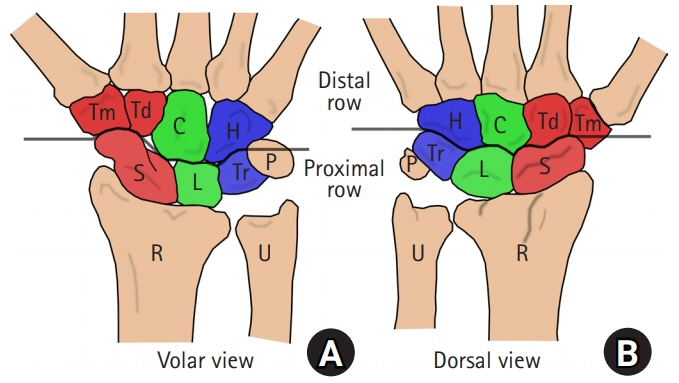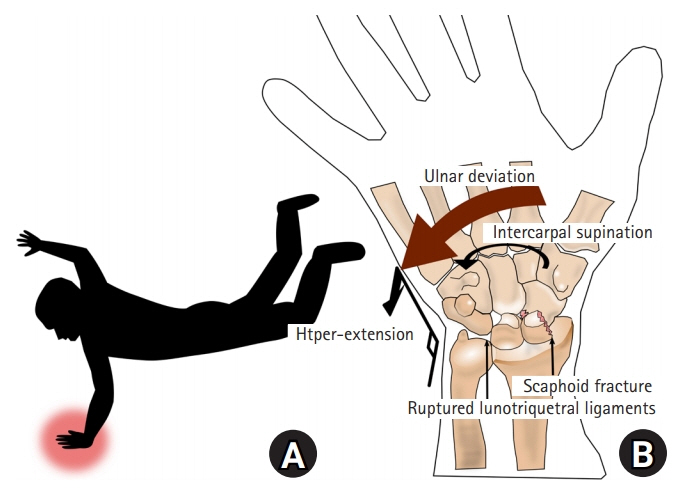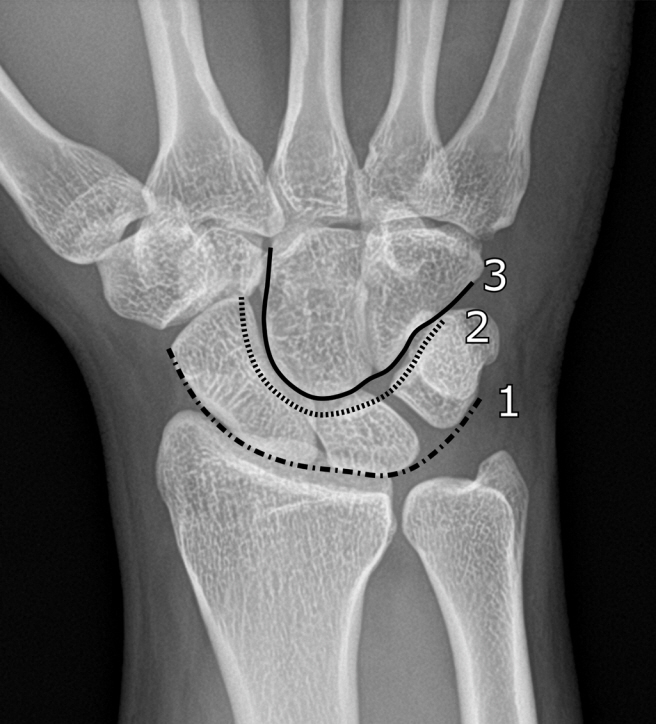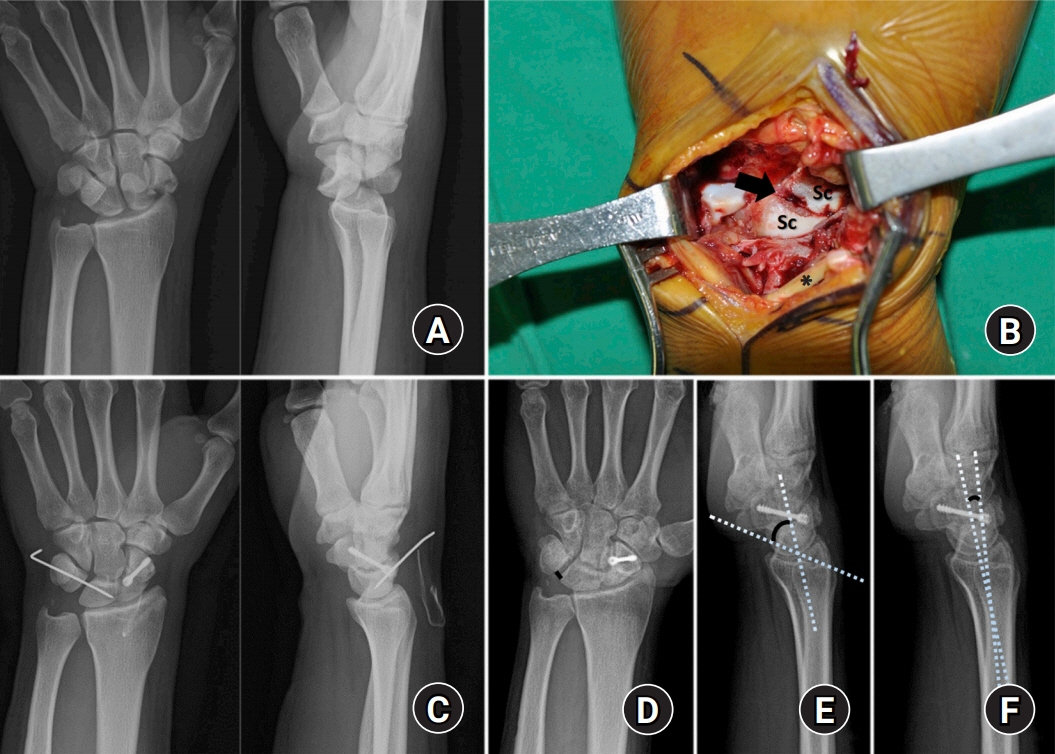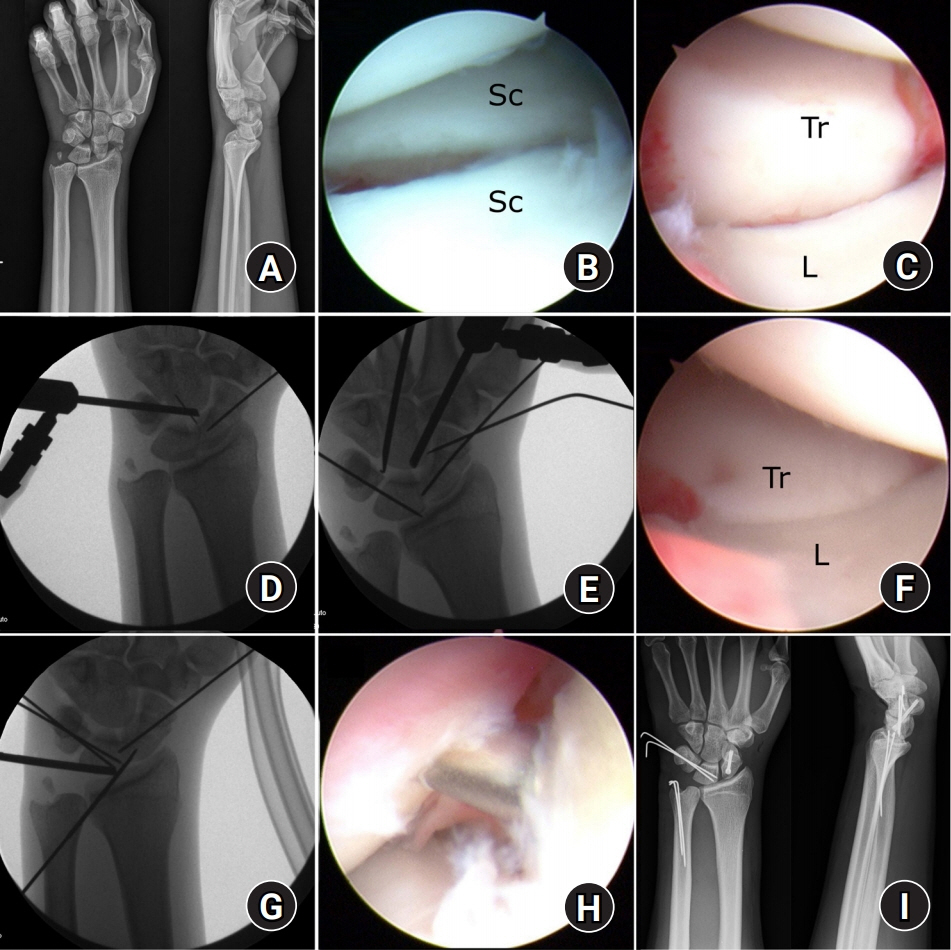Arch Hand Microsurg.
2021 Jun;26(2):69-81. 10.12790/ahm.21.0080.
Trans-scaphoid Perilunate Fracture Dislocation
- Affiliations
-
- 1Department of Orthopaedic Surgery, Yonsei University College of Medicine, Seoul, Korea
- KMID: 2516151
- DOI: http://doi.org/10.12790/ahm.21.0080
Abstract
- Trans-scaphoid perilunate fracture dislocations, which account for more than half of total cases of perilunate injuries, are common in young patients and occur as a result of high-energy injuries, and improper management can impair wrist alignment and function. Understanding the related wrist anatomy and pathomechanics may help surgeons evaluate and diagnose patients. Early operation to reduce and fix the injuries should be considered to achieve optimal clinical and radiological outcomes. In this review article, we present an overview of wrist pathoanatomy, the pathomechanics of trans-scaphoid perilunate fracture dislocations, operative treatment options including an arthroscopic procedure, and reported clinical and radiological outcomes.
Keyword
Figure
Reference
-
1. Berger RA. The anatomy of the ligaments of the wrist and distal radioulnar joints. Clin Orthop Relat Res. 2001; (383):32–40.
Article2. Mayfield JK, Johnson RP, Kilcoyne RK. Carpal dislocations: pathomechanics and progressive perilunar instability. J Hand Surg Am. 1980; 5:226–41.
Article3. Kozin SH. Perilunate injuries: diagnosis and treatment. J Am Acad Orthop Surg. 1998; 6:114–20.
Article4. Muppavarapu RC, Capo JT. Perilunate dislocations and fracture dislocations. Hand Clin. 2015; 31:399–408.
Article5. Grabow RJ, Catalano L 3rd. Carpal dislocations. Hand Clin. 2006; 22:485–500.
Article6. Inoue G, Shionoya K. Late treatment of unreduced perilunate dislocations. J Hand Surg Br. 1999; 24:221–5.
Article7. Komurcu M, Kürklü M, Ozturan KE, Mahirogullari M, Basbozkurt M. Early and delayed treatment of dorsal transscaphoid perilunate fracture-dislocations. J Orthop Trauma. 2008; 22:535–40.
Article8. Green DP, O’Brien ET. Open reduction of carpal dislocations: indications and operative techniques. J Hand Surg Am. 1978; 3:250–65.
Article9. Bathala EA, Murray PM. Long-term follow-up of an undiagnosed trans-scaphoid perilunate dislocation demonstrating articular remodeling and functional adaptation. J Hand Surg Am. 2007; 32:1020–3.
Article10. Bagheri F, Taraz-Jamshidi MH, Birjandinejad A, et al. Trans-scaphoid perilunate fracture-dislocation and isolated perilunate dislocations; surgical versus non surgical treatment. Arch Bone Jt Surg. 2013; 1:74–7.11. Herzberg G, Comtet JJ, Linscheid RL, Amadio PC, Cooney WP, Stalder J. Perilunate dislocations and fracture-dislocations: a multicenter study. J Hand Surg Am. 1993; 18:768–79.
Article12. Sochart DH, Birdsall PD, Paul AS. Perilunate fracture-dislocation: a continually missed injury. J Accid Emerg Med. 1996; 13:213–6.
Article13. Craigen MA, Stanley JK. Wrist kinematics: row, column or both? J Hand Surg Br. 1995; 20:165–70.14. Moritomo H, Apergis EP, Herzberg G, Werner FW, Wolfe SW, Garcia-Elias M. 2007 IFSSH committee report of wrist biomechanics committee: biomechanics of the so-called dart-throwing motion of the wrist. J Hand Surg Am. 2007; 32:1447–53.
Article15. Rainbow MJ, Kamal RN, Leventhal E, et al. In vivo kinematics of the scaphoid, lunate, capitate, and third metacarpal in extreme wrist flexion and extension. J Hand Surg Am. 2013; 38:278–88.
Article16. Rainbow MJ, Wolff AL, Crisco JJ, Wolfe SW. Functional kinematics of the wrist. J Hand Surg Eur Vol. 2016; 41:7–21.
Article17. Mayfield JK, Johnson RP, Kilcoyne RF. The ligaments of the human wrist and their functional significance. Anat Rec. 1976; 186:417–28.
Article18. Herzberg G, Burnier M, Marc A, Merlini L, Izem Y. The role of arthroscopy for treatment of perilunate injuries. J Wrist Surg. 2015; 4:101–9.19. Katz DA, Green JK, Werner FW, Loftus JB. Capsuloligamentous restraints to dorsal and palmar carpal translation. J Hand Surg Am. 2003; 28:610–3.
Article20. Scalcione LR, Gimber LH, Ho AM, Johnston SS, Sheppard JE, Taljanovic MS. Spectrum of carpal dislocations and fracture-dislocations: imaging and management. AJR Am J Roentgenol. 2014; 203:541–50.
Article21. Buijze GA, Lozano-Calderon SA, Strackee SD, Blankevoort L, Jupiter JB. Osseous and ligamentous scaphoid anatomy: Part I. A systematic literature review highlighting controversies. J Hand Surg Am. 2011; 36:1926–35.
Article22. Ritt MJ, Stuart PR, Berglund LJ, Linscheid RL, Cooney WP 3rd, An KN. Rotational stability of the carpus relative to the forearm. J Hand Surg Am. 1995; 20:305–11.
Article23. Viegas SF, Patterson RM, Ward K. Extrinsic wrist ligaments in the pathomechanics of ulnar translation instability. J Hand Surg Am. 1995; 20:312–8.
Article24. Berger RA, Blair WF. The radioscapholunate ligament: a gross and histologic description. Anat Rec. 1984; 210:393–405.
Article25. Berger RA. The ligaments of the wrist: a current overview of anatomy with considerations of their potential functions. Hand Clin. 1997; 13:63–82.26. Short WH, Werner FW, Green JK, Sutton LG, Brutus JP. Biomechanical evaluation of the ligamentous stabilizers of the scaphoid and lunate: part III. J Hand Surg Am. 2007; 32:297–309.
Article27. Sennwald GR, Zdravkovic V, Kern HP, Jacob HA. Kinematics of the wrist and its ligaments. J Hand Surg Am. 1993; 18:805–14.
Article28. Montero Lopez NM, Paksima N. Perilunate injuries and dislocations etiology, diagnosis, and management. Bull Hosp Jt Dis (2013). 2018; 76:33–7.29. Berger RA, Imeada T, Berglund L, An KN. Constraint and material properties of the subregions of the scapholunate interosseous ligament. J Hand Surg Am. 1999; 24:953–62.
Article30. Ritt MJ, Bishop AT, Berger RA, Linscheid RL, Berglund LJ, An KN. Lunotriquetral ligament properties: a comparison of three anatomic subregions. J Hand Surg Am. 1998; 23:425–31.
Article31. Trumble TE, Bour CJ, Smith RJ, Glisson RR. Kinematics of the ulnar carpus related to the volar intercalated segment instability pattern. J Hand Surg Am. 1990; 15:384–92.
Article32. Smith DK. Dorsal carpal ligaments of the wrist: normal appearance on multiplanar reconstructions of three-dimensional Fourier transform MR imaging. AJR Am J Roentgenol. 1993; 161:119–25.
Article33. Mitsuyasu H, Patterson RM, Shah MA, Buford WL, Iwamoto Y, Viegas SF. The role of the dorsal intercarpal ligament in dynamic and static scapholunate instability. J Hand Surg Am. 2004; 29:279–88.
Article34. Pulos N, Bozentka DJ. Carpal ligament anatomy and biomechanics. Hand Clin. 2015; 31:381–7.
Article35. Herzberg G. Acute dorsal trans-scaphoid perilunate dislocations: open reduction and internal fixation. Tech Hand Up Extrem Surg. 2000; 4:2–13.36. Johnson RP. The acutely injured wrist and its residuals. Clin Orthop Relat Res. 1980; (149):33–44.
Article37. Yeager BA, Dalinka MK. Radiology of trauma to the wrist: dislocations, fracture dislocations, and instability patterns. Skeletal Radiol. 1985; 13:120–30.
Article38. Sauder DJ, Athwal GS, Faber KJ, Roth JH. Perilunate injuries. Orthop Clin North Am. 2007; 38:279–88.
Article39. Adkison JW, Chapman MW. Treatment of acute lunate and perilunate dislocations. Clin Orthop Relat Res. 1982; (164):199–207.
Article40. Peh WC, Gilula LA. Normal disruption of carpal arcs. J Hand Surg Am. 1996; 21:561–6.
Article41. Stanbury SJ, Elfar JC. Perilunate dislocation and perilunate fracture-dislocation. J Am Acad Orthop Surg. 2011; 19:554–62.
Article42. Jones RW. Carpal semilunar dislocations and other wrist dislocations with associated nerve lesions. Proc R Soc Med. 1929; 22:1071–86.
Article43. Jasmine MS, Packer JW, Edwards GS Jr. Irreducible trans-scaphoid perilunate dislocation. J Hand Surg Am. 1988; 13:212–5.
Article44. Apergis E, Maris J, Theodoratos G, Pavlakis D, Antoniou N. Perilunate dislocations and fracture-dislocations: closed and early open reduction compared in 28 cases. Acta Orthop Scand Suppl. 1997; 275:55–9.45. Budoff JE. Treatment of acute lunate and perilunate dislocations. J Hand Surg Am. 2008; 33:1424–32.
Article46. Krief E, Appy-Fedida B, Rotari V, David E, Mertl P, Maes-Clavier C. Results of perilunate dislocations and perilunate fracture dislocations with a minimum 15-year follow-up. J Hand Surg Am. 2015; 40:2191–7.47. Chou YC, Hsu YH, Cheng CY, Wu CC. Percutaneous screw and axial Kirschner wire fixation for acute transscaphoid perilunate fracture dislocation. J Hand Surg Am. 2012; 37:715–20.
Article48. Goodman AD, Harris AP, Gil JA, Park J, Raducha J, Got CJ. Evaluation, management, and outcomes of lunate and perilunate dislocations. Orthopedics. 2019; 42:e1–6.
Article49. Herzberg G. Perilunate and axial carpal dislocations and fracture-dislocations. J Hand Surg Am. 2008; 33:1659–68.
Article50. Knoll VD, Allan C, Trumble TE. Trans-scaphoid perilunate fracture dislocations: results of screw fixation of the scaphoid and lunotriquetral repair with a dorsal approach. J Hand Surg Am. 2005; 30:1145–52.
Article51. Inoue G, Kuwahata Y. Management of acute perilunate dislocations without fracture of the scaphoid. J Hand Surg Br. 1997; 22:647–52.
Article52. Inoue G, Imaeda T. Management of trans-scaphoid perilunate dislocations: Herbert screw fixation, ligamentous repair and early wrist mobilization. Arch Orthop Trauma Surg. 1997; 116:338–40.53. Hildebrand KA, Ross DC, Patterson SD, Roth JH, MacDermid JC, King GJ. Dorsal perilunate dislocations and fracture-dislocations: questionnaire, clinical, and radiographic evaluation. J Hand Surg Am. 2000; 25:1069–79.
Article54. Melone CP Jr, Murphy MS, Raskin KB. Perilunate injuries: repair by dual dorsal and volar approaches. Hand Clin. 2000; 16:439–48.55. Liu B, Chen SL, Zhu J, Wang ZX, Shen J. Arthroscopically assisted mini-invasive management of perilunate dislocations. J Wrist Surg. 2015; 4:93–100.56. Park MJ, Ahn JH. Arthroscopically assisted reduction and percutaneous fixation of dorsal perilunate dislocations and fracture-dislocations. Arthroscopy. 2005; 21:1153.
Article57. Jeon IH, Kim HJ, Min WK, Cho HS, Kim PT. Arthroscopically assisted percutaneous fixation for trans-scaphoid perilunate fracture dislocation. J Hand Surg Eur Vol. 2010; 35:664–8.
Article58. Kim JP, Lee JS, Park MJ. Arthroscopic reduction and percutaneous fixation of perilunate dislocations and fracture-dislocations. Arthroscopy. 2012; 28:196–203.
Article59. Liu B, Chen SL, Zhu J, Tian GL. Arthroscopic management of perilunate injuries. Hand Clin. 2017; 33:709–15.
Article60. Oh WT, Choi YR, Kang HJ, Koh IH, Lim KH. Comparative outcome analysis of arthroscopic-assisted versus open reduction and fixation of trans-scaphoid perilunate fracture dislocations. Arthroscopy. 2017; 33:92–100.
Article61. Song D, Goodman S, Gilula LA, Wollstein R. Ulnocarpal translation in perilunate dislocations. J Hand Surg Eur Vol. 2009; 34:388–90.
Article62. Savoie FH 3rd, Grondel RJ. Arthroscopy for carpal instability. Orthop Clin North Am. 1995; 26:731–8.
Article63. Souer JS, Rutgers M, Andermahr J, Jupiter JB, Ring D. Perilunate fracture-dislocations of the wrist: comparison of temporary screw versus K-wire fixation. J Hand Surg Am. 2007; 32:318–25.
Article64. Wong TC, Ip FK. Minimally invasive management of trans-scaphoid perilunate fracture-dislocations. Hand Surg. 2008; 13:159–65.
Article
- Full Text Links
- Actions
-
Cited
- CITED
-
- Close
- Share
- Similar articles
-
- Bilateral Trans-Scaphoid Perilunate Fracture Dislocation
- Fracture of the Capitate with Velar Perilunate Dislocation: One case report
- Perilunate Dislocations and Fracture-Dislocations
- Headless Autocompression Screw Fixation of Scaphoid Fractures Using Open Dorsal Approach
- Trans-Scaphoid Perilunate Dislocation with Fractured Carpal Bones in a Child: A Case Report

